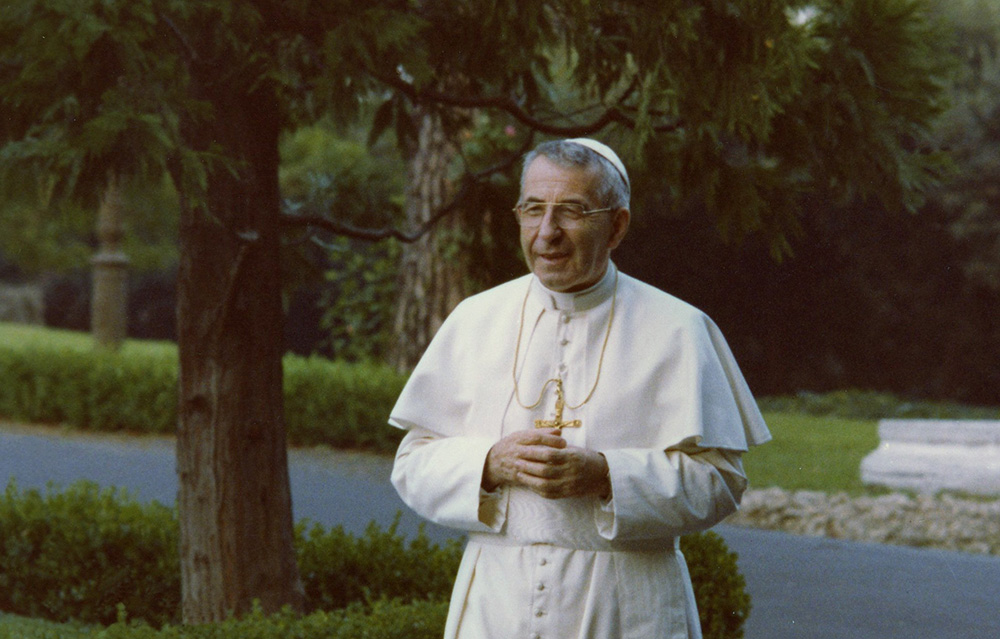
DUNWOODIE — The papacy of Blessed John Paul I lasted just 34 days; but a series of achievements in his life have made “the smiling pope” a worthy candidate for sainthood.
This year marks the 45 anniversary of John Paul I’s death. Born Albino Luciani in 1912, he was elected to the papacy on Aug. 26, 1978, and succumbed to a heart attack on Sept. 28 — marking his one of the shortest papacies ever.
Still, Catholics have sought his intercession and hoped for his canonization.
In 2021, Pope Francis recognized the miraculous 2011 healing of Candela Giarda, a girl in Argentina who recovered from encephalitis, diagnosed as fatal, after her family and parish priest prayed for the intercession of Pope John Paul I.
Subsequently, Pope Francis last year gave him beatification — one miracle away from sainthood.
Luciani was born Oct. 17, 1912, in Canale d’Agordo, a town in northern Italy, and ordained a priest in 1935. He never served as a pastor but became a seminary professor, vicar general, and author.
John Paul I was quick to grin, giving him the nickname “papa del sorriso” — “the smiling pope,” said Father Michael Bruno, professor of church history at St. Joseph’s Seminary in Dunwoodie.
“There’s a beautiful quote attributed to Mother Teresa that he was a ‘sunbeam of God’s love,’ ” Father Bruno said.
His life would mark several “firsts,” like the first pope born in the 20th century.
Also, he became the first pope to select two names. He did so to honor predecessors who mentored him — Popes John XXIII and Paul VI, Father Bruno said.
Pope John XXIII made him a bishop of Vittorio Veneto, also in northern Italy, in 1958.
“His time even as a bishop was quite substantive in terms of his own governance of his see, but also his participation at the Second Vatican Council,” Father Bruno said.
In 1969, Pope Paul appointed him patriarch of Venice and the cardinal-priest at Rome’s San Marco basilica in 1973.
Pope Paul’s death on Aug. 6, 1978, prompted a conclave in which Luciani was not initially considered electable, but a few fellow cardinals thought otherwise. He became pope in a fourth balloting.
“The idea of many was it would have been a cardinal who worked in the Curia — someone who had worked in diplomacy,” Father Bruno said. “Remember, the Cold War was still raging.
“But they chose a diocesan bishop known for his pastoral acumen and his outreach to his people.”
The new pope immediately set out to humanize the papacy. In another first, he purposely referred to himself in the first-person “I” instead of the traditional royal “we.”
Although he never served as a Vatican diplomat, Pope John Paul I vigorously promoted reconciliation and peace among peoples and religions. It was a lofty goal, considering global turmoil in the 1970s, with wars in Southeast Asia, Central and South America, and the Middle East.
A few days before his death, the pope praised the U.S. government’s peace-brokering efforts under President Jimmy Carter’s leadership.
“Yesterday,” he told a general audience on Sept. 20, 1978, “the American Congress burst into applause that we also heard when Carter quoted the words of Jesus: ‘Blessed are the peacemakers.’ I truly hope that that applause and those words will enter the hearts of all Christians, especially we Catholics.”
The death of Pope John Paul I set the stage for the papacy of Pope John Paul II. It also made for one of the rare “Year of Three Popes,” which occurs when a newly-elected pope dies or resigns very early into his papacy. Thus, in 1978, Catholics were led by Popes Paul VI, John Paul I, and John Paul II.
But did you know that 34 days of John Paul I’s papacy is not even in the Top 10 shortest papal reigns? Here is that list:
- Urban VII (Sept. 15-27, 1590): reigned for 13 days; died of malaria.
- Boniface VI (April 11-26, 896): reigned for 16 days; died of gout.
- Celestine IV (Oct. 25-Nov. 10, 1241): reigned 17 days; died of fatigue before coronation.
- Theodore II (December 897): reigned 20 days; died of an unknown cause.
- Sisinnius (Jan. 15-Feb. 4, 708): reigned for 21 days; suffered from gout, died.
- Marcellus II (April 9-May 1, 1555): reigned 23 days; had a stroke, died.
- Damasus II (July 17-Aug. 9, 1048): reigned for 24 days; died of possible malaria.
- Pius III (Sept. 22-Oct. 18, 1503): reigned for 27 days; died of infection from leg sore.
- Leo XI (April 1-27, 1605): reigned for 27 days; died of fever.
- Benedict V (May 22 -June, 23, 964): reigned 33 days; overthrown and exiled.
- John Paul I (Aug. 26-Sept. 28 1978): reigned 34 days, died of heart attack.
